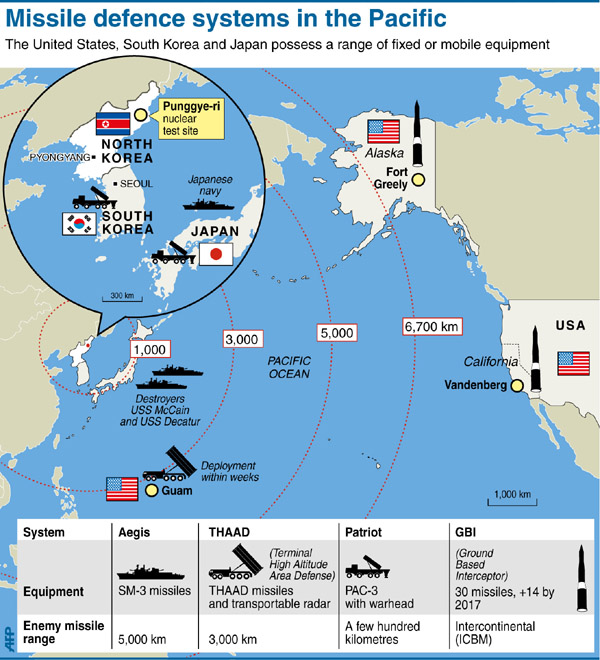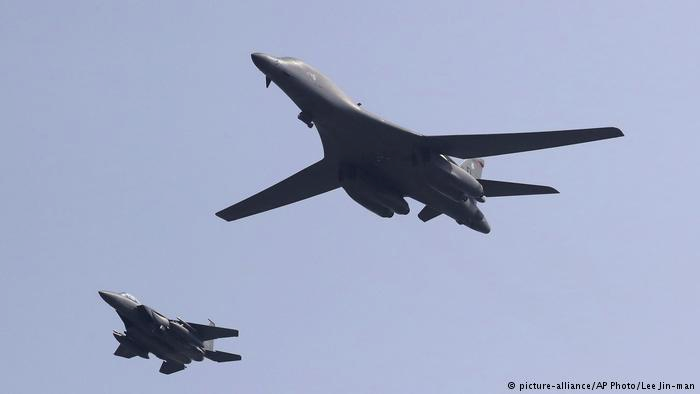A nice little article from AFP: https://www.yahoo.com/news/chronology-north-korean-missile-development-011251742.html
Key dates: 1999, 2000, 2005, 2006, 2009, 2016 and of course 2017.

Excellence in Historical Research and Analysis

Excellence in Historical Research and Analysis
A nice little article from AFP: https://www.yahoo.com/news/chronology-north-korean-missile-development-011251742.html
Key dates: 1999, 2000, 2005, 2006, 2009, 2016 and of course 2017.
But still might be able to hit Alaska: North Korean Missiles are Hoax

Don’t want to steal Shawn’s thunder as he is working up an article on THAAD, but this is a nice little graphic showing the defense of the area: U.S. can Intercept North Korean ICBMs with 36 Deployed Interceptors
We do have THAADs deployed in Hawaii, Guam, South Korea and Alaska (the map does not show them in Hawaii, South Korea nor Alaska). The U.S. Army has five THAAD batteries that are part of the 11th Air Defense Artillery Brigade.
There are only 4 GBI’s (ground based interceptors) in Vandenberg. There is some question over the ability of a THAAD to intercept an ICBM (vice an IRBM), but we will let Shawn discuss that. Not sure how many Aegis systems we have in the area, but as they are sea based, it could several and they can move. Again, not sure about their ability to intercept an ICBM (Intercontinental Ballistic Missile vice the much smaller IRBM, Intermediate Range Ballistic Missile). Korea is currently threatening Guam with four IRBMs. They most likely do not yet have a nuclear warhead with a working ballistic vehicle (BV) connected to an ICBM, but may be less than a year away from this capability.

While North Korea tests its inter-continental ballistic missiles (ICBM)s, the U.S. and China demonstrate their capabilities and resolve to use force, both nuclear and conventional. These shows of force seem to be ratcheting up, as the North Korean tests occur more frequently. Flights of bombers and naval exercises are also complemented by words, sometimes quite strong words, such as those by the U.S. Pacific Fleet Commander, Admiral Scott Smith, who while speaking at the Australian National University’s security conference in late July, said,
Every member of the U.S. military has sworn an oath to defend the constitution of the United States against all enemies foreign and domestic and to obey the officers and the president of the United States as commander and chief appointed over us.
[Photo deleted at the request of AFP]
China, meanwhile, has staged two different naval exercises in the Yellow Sea, likely organized to mark the People’s Liberation Army’s (PLA) 90th Anniversary on August 1st, 2017. It is ironic that naval exercises celebrate the Army’s anniversary, and that concurrently the PLA is shrinking relative to the Chinese Navy and Air Force. “The PLA Army will likely take the brunt of the reduction, and the PLA Navy and Air Force are expected to increase in size,” according to Dr. David Finkelstein of the Center for Naval Analysis. Both the Navy, officially the People’s Liberation Army Navy (PLAN) and the Air Force, officially the People’s Liberation Army Air Force (PLAAF) are nominally part of the PLA.
It is also ironic that these naval exercises will close a portion of the maritime commons to commercial traffic, also known as Sea Lines of Communication (SLOC), articulated by Alfred Thayer Mahan, of the U.S. Naval War College.
The PLA Navy’s North Sea Fleet and the Shandong Maritime Safety Administration announced in the past two days that the central part of the Yellow Sea would be cordoned off to all marine traffic from Thursday for military purposes. An area of about 40,000 square kilometres off the coastal city of Qingdao, where the North Sea Fleet is headquartered, was expected to be affected by the drill, which would involve live ammunition, Weihai Evening Post reported on Wednesday. [Korea Times]

The US Marine Corps (USMC) has deployed the F-35B to their forward operating base in Iwakuni Japan, and continues to innovate with their doctrine and Concepts Of Operation (CONOPS), as previously reported in this blog. This stealth strike fighter capability, on the relative doorstep of North Korea, and also relatively difficult to reprisal strikes from North Korea, seems to be one of the strongest deterrent forces.
More to follow on the on-going F-35 debate, as retired Marine Lt. Col. David Berke (also previously quoted in this blog), and Pierre Sprey go head to head on the topic in an Aviation Week podcast.
Just a listing by strength of active duty personnel (Army, Navy and Air Force). U.S. and some of its allies are in bold. Allies = countries we are obligated to defend by treaty or law (Taiwan), a total of 48 (in bold are the 27 NATO members, Japan, South Korea, Taiwan, Philippines and Australia), including 16 Latin American nations in the Rio pact (but not placed in bold):
……
Rio Pact includes Argentina, Bahamas, Brazil, Chile, Colombia, Costa Rica, Dominican Republic, El Salvador, Guatemala, Haiti, Honduras, Panama, Paraguay, Peru, Trinidad and Tobago, Uruguay and of course, the United States.
This listing is drawn from Wikipedia: https://en.wikipedia.org/wiki/List_of_countries_by_number_of_military_and_paramilitary_personnel
It is based upon the 2014 edition of “The Military Balance” by IISS.
They also have a number of other lists…if that is your thing:
This article, while a little more political than I prefer, does nicely address the reasons why building up to a 350-355 ship navy is going to be a challenge: Trumps-navy-is-already-sunk
The main points are:
Mark Green has been nominated as Secretary of the Army: army-secretary-pick
Here is his Wikipedia bio: Mark_Green_(politician)
West Point class of 1986. Platoon and Company commander, then went to medical school becoming a doctor. Was a flight surgeon in special operations. Served in Iraq and Afghanistan. Was the doctor who first sat with and interviewed Saddam Hussein when he was captured. Wrote a book about it: night-saddam-Mark-Green-md
Left service in 2006 after 20 years. Founded a medical company. Elected to the Tennessee Senate in 2012.
I guess we will have to see how the third nominee for Secretary of the Army fares.
With the budget resolution voted in by congress that runs until the September of this year (end of the fiscal year), I gather the defense budget is the Obama proposed 2017 defense budget plus $15 billion (which is half of the additional budget that Trump requested for 2017)….so total budget of around $583 (2017 request) or $596 (actually spent) + $15 billion: https://www.yahoo.com/finance/news/lawmakers-common-ground-1t-plan-201456675.html
Also see: https://en.wikipedia.org/wiki/Military_budget_of_the_United_States
The big increase will have to wait for the FY 2018 budget, proposed to be $639 billion (I gather, although the figure $603 was put out when Trump first announced his 10% increase). Of course, they did not fully sort out the FY2017 budget until five months before fiscal year 2017 ended, so I am not giving much of chance that they will get the FY 2018 budget sorted out before the start of the next fiscal year (this coming October), as I gather there a few controversial expenditures and cuts in the next government budget. So defense spending will remain fairly level for some months to come.
…
P.S.: The 15 billion increase is an additional 12.5 billion for this fiscal year (ends Sept. 30) and “…an additional $2.5 billion contingent on Trump delivering a plan to Congress for defeating the Islamic State militant group.” This last part seems a little odd: http://www.csmonitor.com/USA/Politics/2017/0501/To-avoid-government-shutdown-negotiators-reach-deal-on-1-trillion-budget
Well, it looks like the National Security Council has been re-structured in the first three months of the administration, with the original head Flynn replaced by H.R. McMaster, Steve Bannon removed from it, the Chairmen of the JCS and Director of National Intelligence invited back, and Deputy National Security Advisor K.T. McFarland “promoted” to ambassador to Singapore. Dina Powell remains as the Deputy National Security Advisor for Strategy. This is a wholesale change in the first three months of the administration. It is still lacking the traditional highly experienced foreign policy scholar or professional in the mode of a Kissinger, Brzezinski, or Scowcroft. McMaster’s reputation was as a combat commander, not a foreign policy expert.
My old post on the subject was: https://dupuyinstitute.dreamhosters.com/2016/12/15/what-is-missing/
I tend to have a bias towards experienced professionals running government agencies.
Mark Green has been nominated as Secretary of the Army: army-secretary-pick
Here is his Wikipedia bio: Mark_Green_(politician)
West Point class of 1986. Platoon and Company commander, then went to medical school becoming a doctor. Was a flight surgeon in special operations. Served in Iraq and Afghanistan. Was the doctor who first sat with and interviewed Saddam Hussein when he was captured. Wrote a book about it: night-saddam-Mark-Green-md
Left service in 2006 after 20 years. Founded a medical company. Elected to the Tennessee Senate in 2012.